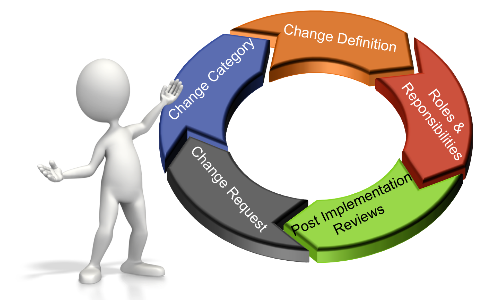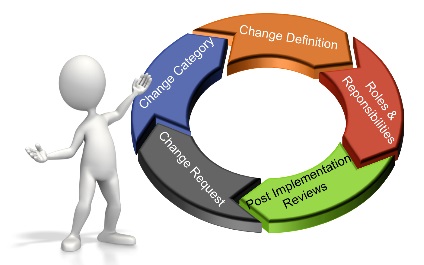Change Management Communication
Effective management of change provides a structured, consistent, and measurable change environment to be utilized across an organization and is a critical component in the success of its daily business. Its goal is to increase awareness and understanding of proposed changes across the organization and ensure that all changes are made in a thoughtful way that minimize negative impact to services and customers. An organization should have a document that defines the implementation of Change Management procedure. The computing systems, networks, peripherals, and associated facilities are subject to continuous changes driven by new technology, evolving business requirements, changing contractual requirements, and growing regulatory policies. Effective change management applies to both systems and supporting infrastructure, and is a necessary component for the continuous success and growth of the organization.

Effective Change Management - Change Communication
In the previous blog we discussed how to document changes. Changes need to be documented and updated throughout the change management process. Important information must be captured for each CR regardless of change management tool (sophisticated software or CRF). The mandated information is required for adequate review by others before approving the requested change. Today, in the final discussion of the change management series, we are discussing the role that communications play in the change management process. Communication is the bedrock of the change management process, and it happens at the very beginning and throughout the whole process. Good communication increases the efficiency of the process and reduces the possibility of errors due to miscommunication.
Change Policy and Processes
Change policy and processes need to be clearly defined and communicated to all parties involved. This requires the IT management to establish the policy and processes and provide needed training. The documents in question should be stored in a public folder (such as network share or SharePoint) where employees have access readily. The communications for change policies and processes are top-down drive, and they set clear boundaries, tasks, and make employees understand their roles and responsibilities.
Communication within a Change
The communications start when there is a need for change. It could be a problem identified by an end user who may not know that a change is needed. Only after the end user reports the problem to the technical staff who troubleshoot and identify the cause (could involve code change or configuration change), is a change needed. During which time, the technical staff and the end user communicate frequently to work together and pinpoint the cause of the problem. A change could also be initiated from the IT side. There may be new updates or version for a software, which add new functionalities. IT should to communicate this to the business owners about the new version and functionalities and get the business onboard with the change.
After the need for a change is identified, there is more communication between the change requester, developer, and end users to get business requirements, develop the changes, and test the change. The communication in this phase is on-going until the closure of the change ticket.
Change Approval Communication
The change manager plays a central and key role during the change approval communication. The change manager is responsible for checking the quality of the submitted Change Requests (CR). If there are any required elements is missing, the change manager communicates with the change requestor to update the CR with required information. Communications are also required prior to the change meeting where the change review board (CRB) reviews and approves the changes. Normally, the change manager distributes a list of submitted CRs to the CRB and involved parties before the change meeting. This communication provides the change approvers ample time to assess and review the changes and be prepare for the change meeting. During this phase, there may be communication between the change manager, requestors, and approvers about change justification, clarification, and change window.
After the change is approved or rejected, the result is documented, the change manager communicates the result to the CRB and change requestors.
Many of the change manager’s functions are replaced by sophisticated change management systems nowadays. Some of the communications/notifications are managed automatically by the systems. For example, some systems will not allow submittal of a CR unless all required information is obtained, and some systems will send out notifications to the change approvers to review and approve changes.
Post Change Implementation Review and Change Closure Communication
The change process is not complete just because a change has been implemented in the production environment. Depending on the change policy of the organization, a post implementation review is required. Some organizations do not review all changes post implementation, but only failed implementations and emergency changes. The goal of post implementation is to understand the cause of the failures or the emergency changes, and to explore other change options and learn from the mistakes.
There should be communication between the change requestor and the end users to ensure that the change implemented in the production meets the requirements and is working desired. Again, depending on the organization, some require final user acceptence before closing the change ticket, and some require final user acceptence and sign off only for major changes.
Change Metrics and Reports
Another Change Manager function is to generating the information regarding performance to pre-defined change metrics and ensures reports are available either on-line or via e-mail distribution. This communication is to provide management information about change management quality and operations.
In summary, communication is the bedrock of the change management process, and it happens at the very beginning and throughout the entire change management process. Good communication increases the efficiency of the process and reduces the possibility of errors due to miscommunication.
We have discussed change management key areas through the change management series. Sound change management policy and processes manage all changes in a controlled manner, including standard changes and emergency maintenance relating to business processes, applications and infrastructure. They also enable fast and reliable delivery of change to the business and mitigation of the risk of negatively impacting the stability or integrity of the changed environment. Please contact Carrtegra to improve your change management process.
To get a FREE copy of our Premium Content "Effective Change Management - Change Communication.pdf", simply click this button.
Get Our Premium Content: Change Management Ten Key Performance Metrics

